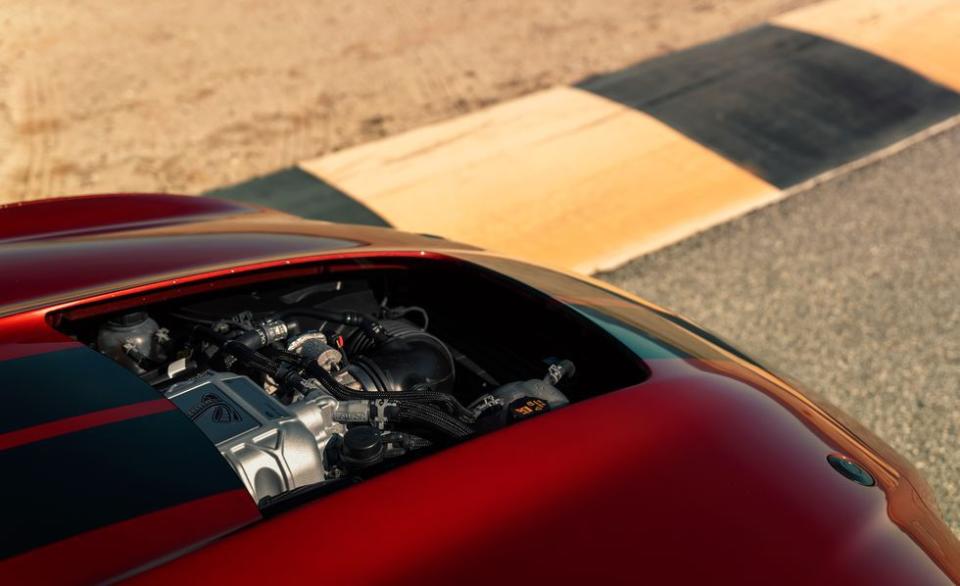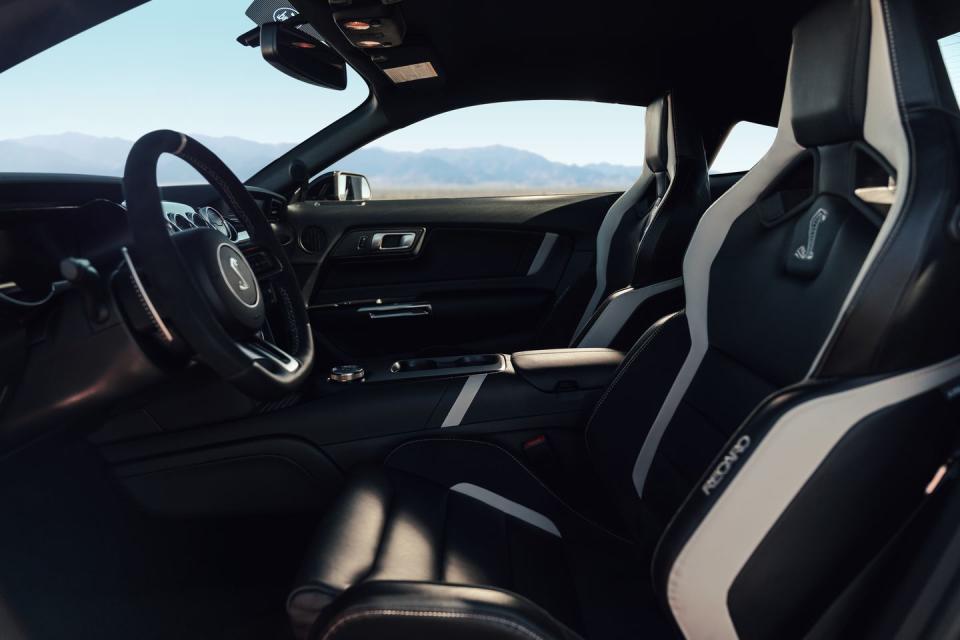The 2020 Ford Mustang Shelby GT500 Enters the Horsepower Wars against the Hellcat and ZL1

It had to happen. You didn't think Ford was going to sit around in Dearborn, Michigan, gnawing on chicken shawarma sandwiches while its competitors built Hellcats and ZL1s, did you? Carmakers might be dumping increasingly large loads of money into ride-sharing schemes and electric cars, but meanwhile the big-boy pony cars are playing with 700-plus horsepower. Seven-hundred-plus horsepower. Think about that for a second. The Le Mans–class-winning, half-million-dollar Ford GT makes 647 horsepower. A $300,000 McLaren 720S only just crests the 700-hp summit. And the Porsche 911 Turbo S produces a paltry 580.
So, yes, Ford has launched the latest salvo in this power war with the 2020 Shelby GT500. It is what longtime Mustang designer Melvin Betancourt describes as the model line's "holy shit" car. Holy shit indeed.

The supercharged V-8 thumper makes-drum roll, please-"700-plus" horsepower. Ford won't say precisely what the GT500 will be rated at and claims it won't have official numbers until this summer, mere months before the vehicle goes on sale. But it doesn't make much sense for Ford to produce a vehicle that makes less power than its main adversaries. The Blue Oval will need to best the output of Chevy's 650-hp Camaro ZL1 and the Dodge Challenger's updated 717-hp Hellcat. We're guessing that the GT500 will come in around its rumored 720 horsepower and pump out in the neighborhood of 650 pound-feet of torque.
Whatever the numbers, they'll come from a supercharged DOHC 5.2-liter V-8 derived from the one-rung-lower GT350's engine. The GT500's shares the lesser Shelby's 94.0-millimeter bore and 93.0-millimeter stroke but not its flat-plane crankshaft, and it redlines at 7500 rpm, 700 lower than the naturally aspirated engine. But who needs insane revs when an Eaton TVS R2650 supercharger is nestled atop the engine? It's the same 2.7-liter unit used in the 755-hp Chevrolet Corvette ZR1 and crams 12 psi of boost into an internally strengthened V-8. The engine has a new cast-aluminum structural oil pan, which has both static baffles and hinged doors that open and close under high g-forces to fend off oil starvation. Ford Performance chief functional engineer Ed Krenz says this allows for sustained track survivability without a dry-sump system. Likewise, says Krenz, the upgraded cooling package compared with a GT350 will keep the engine happy on long track runs. It includes an air-to-liquid intercooler mounted atop the supercharger, an upgraded radiator, an engine-oil cooler, and a transmission-oil cooler.

Torque flows to a Tremec-sourced seven-speed dual-clutch transmission developed for this application. There will be no manual. Krenz claims that the transmission is capable of shifts in about a tenth of a second; roughly what a Porsche PDK can do and about twice as quick as shifts from the Chevy ZL1's optional 10-speed automatic. The dual-clutch will respond differently depending on the drive mode selected. Drag mode will deliver shifts with no torque interruption, and Track mode will take steering angle, among other parameters, into account to prevent an abrupt shift that could destabilize the car. It can be left in automatic mode or controlled via magnesium shift paddles. Predictably, the software includes launch control and a line-lock feature. Power routes rearward through a carbon-fiber driveshaft to a Torsen limited-slip rear end carrying 3.73:1 gears and out to the wheels via beefed-up half-shafts and CV joints. Exhaust gases exit through four tailpipes, each a girthy five inches in diameter.
Ford is adamant that, unlike previous iterations, this GT500 will go left and right just as well as it proceeds in a straight line. Using the brilliant-handling GT350 as a basis for the big-power car is a good start. It will carry the same basic strut front and multilink rear suspensions as the GT350. But in addition to using stiffer springs, fatter anti-roll bars, and retuned magnetorheological dampers, the GT500's front suspension has revised geometry aimed at reducing the tramlining that's omnipresent in the GT350-we expect that the GT350 will also receive this modification soon. The increased stiffness helps to manage the GT500's greater mass compared with the GT350 and the increased unsprung weight of the standard 20-inch wheel-and-tire package. The standard wheels are aluminum and wrapped in Michelin Pilot Sport 4S summer tires, sized 305/30ZR-20 in front and 315/30ZR-20 in the rear. The optional Carbon Fiber Track package brings carbon-fiber wheels wearing Michelin Pilot Sport Cup 2 track tires, an adjustable carbon-fiber wing, a rear-seat delete, and dive planes up front. All GT500s carry a strut-tower brace made of an elaborate magnesium latticework. The 20-inch wheels were necessitated by the standard two-piece iron-and-aluminum brake rotors. Measuring 16.5 inches, the front rotors are grabbed by six-piston Brembo calipers. The rears are 14.6 inches in diameter and carry four-piston calipers.

Apart from a new rear diffuser and different optional wings, the GT500 is little different from a GT350 from the A-pillar rearward. Forward of the A-pillar, though, pretty much everything is new. The front fenders, made of sheet molding compound (SMC), are 0.4 inch wider on each side to make room for the front rubber. The power-bulge hood that accommodates the increased height of the engine is also made of SMC and incorporates hood pins and a massive vent to exhaust hot air from the engine bay and reduce aerodynamic lift on the nose. This huge (31-by-28-inch) opening is why the GT500, unlike the GT350, has an enclosed intake element; gotta keep it dry. Ford also includes a removable rain tray. Pull it out for maximum air extraction; insert it for minimum water intrusion. The gaping maw is underlined by a big splitter.
Ford says the GT500 will do zero to 60 in the mid-three-second range, which we think might be a bit conservative (an automatic ZL1 will do a 3.4). The company further claims a quarter-mile run of less than 11 seconds, a good half-second quicker than the ZL1. In both performance parameters, the GT500 should trounce the Hellcat. Yes, even the 797-hp Hellcat Redeye Widebody. Advantage: Ford.
('You Might Also Like',)

 Yahoo Autos
Yahoo Autos 